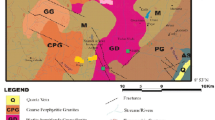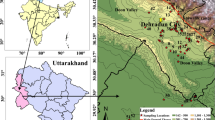Abstract
Uranium mineralization in parts of northeastern Nigeria necessitated its exploration during early eighties by the Nigeria Uranium Mining Company (NUMCO) which was later abandoned. During their course of decay, uranium isotopes pass through radioactive decay stage and eventually into stable isotope of lead. The course of concern for soluble uranium in groundwater especially from the mineralized areas include ionizing radiation, chemical toxicity and reproductive defects for which ingested uranium has been implicated to have caused. This study is aimed at assessing the levels of concentration of uranium in groundwater to ascertain its compliance with the World Health Organization’s (WHO) and the United State Environmental Protection Agency’s (EPA) guideline for uranium in drinking water. Thirty five groundwater samples were collected using EPA’s groundwater sampling protocol and analyzed at the Department of Geology, University of Cape Town using an Inductively Coupled Plasma Mass Spectrometric (ICP-MS) technique. Significant finding of this work was that there is radiological contamination of groundwater in the area. There is also an indication that the extent of radiological contamination is not much within the mineralized zones, therefore, there is likelihood that groundwater has acted as a medium of transporting and enhancing uranium in groundwater in an environment away from that of origin. About 5.7 % of the samples studied had uranium concentration above WHO and EPA’s maximum contaminant level of 30 μg/L which is a major concern for inhabitants of the area. It was also apparent that radiological contamination at the southwestern part of the study area extends into the adjacent sheet (sheet 152). Uranium concentration above set standards in those areas might have originated from rocks around established mineralized zones but was transported to those contaminated areas by groundwater that leaches across the host rock and subsequently mobilizing soluble uranium along with it.





Similar content being viewed by others
References
Akerblom G, Lindgren J (1997) Mapping of groundwater radon potential. Eur Geol 5:13–22
Bhatt KB, Saklani S (1996) Hydrogeochemistry of the upper Ganges river, India. J Geol Soc India 3(48):171–182
Bleise A, Danesi PR, Burkart W (2003) Properties use and health effects of depleted uranium (DU): a general overview. J Environ Radio 64(2–3):93–112
Brindha K, Rajesh R, Murugan R, Elango L, Nair RN (2010) Spartial and seasonal variation in groundwater levels and uranium concentration in Peddagattu and Seripalli area of Nalgonda district, Audhra, Pradesh, India. In: Proceedings of the seventh national symposium on environment (NSE-17), Centre for Environmental Science and Engineering, India Institute of Technology, Kanpur, Kanpur 208016, U.P 2010
Central Water Commission (2000) Water and related statistics. Central Water Commission, Ministry of Water Resources, Govt. of India, New Delhi, India, 75 p
EPA (2010) The analysis of regulated contaminant occurrence data from public water systems in support of the second six-year review of national primary drinking water regulations. EPA-815-B-09-006 Office of Water (4607 M). www.epa.gov/safewater. Accessed September 2010
Funtua II (1992) Geology and geochemistry of uranium mineralization in Mika Northeastern Nigeria. Unpublished Ph.D Thesis, Ahamdu Bello University, Zaria, Nigeria
Jia Guogang, Belli Maria, Sansone Umberto, Rosamilia Silvia, Gaudino Stefania (2005) Concentration and characteristics of depleted uranium in water, air and biological samples collected in Serbia and Montenegro. Appl Radiat Isotopes 63(3):381–399
Hakam OK, Choukri A, Moutia Z, Chouak A, Cherkaoui R, Reyss JL, Lferde M (2001) Uranium and radium in groundwater and surface water samples in Morocco. Radiat Phys Chem 61(3):653–654
Hess CT, Michel J, Harton TR, Procured HM, Coniglio WA (1985) The occurrences of radioactivity in public water supplies in United States. Health Phys 48(5):553–586
International Atomic Energy Agency/Water Resources program (2010) Water sampling procedure for isotope hydrology. Video clip by IAEA Vienna. www-naweb.iaea.org/napc/ih/index.html
Kurttio P, Auvinen L, Salonen H, Saha J, Pekkanen I, Matelainen S, Veisanen IP, Kumolainen I (2002) Renal effects of uranium in drinking water. Environ Health Perspect 110:337–342
Lal D, Suess HE (1968) The radioactive of the atmosphere and hydrosphere. Ann Rev Nuclear Sci 18:407–434
Lyengar MAR (1990) The natural distribution of radium. The environmental behaviour of radium, vol 310. Int Atomic Energy Agency, Vienna, pp 59–128
Mahesh HM, Avadhani DN, Someshekarappa HM, Karunakara N, Narayana Y, Siddappa K (2001). Uranium concentration in water samples in the environment of coastal Karnataka and Kaiga. In: Proc Nat Sem Atom Energ Ecol Environ 113-116
NGSA (2004) Geologic map of Nigeria, Nigeria Geological Survey Agency. 2004 edition, published with the authority of the Government of the Federal republic of Nigeria
Nisi B, Buccianti A, Vaselli O, Perini G, Tassi F, Minissale A et al (2008) Hydrogeochemistry and strontium isotopes in the Arno river basin (Tuscany, Italy): constraints on natural controls by statistical modeling. J Hydrol 360:166–183
Reimann C, Banks D (2004) Setting action levels for drinking water: are we protecting our health or our economy (or our backs!)? Sci Total Environ 332:13–21
Schot PP, Van der Wal J (1992) Human impact on regional groundwater composition through intervention in natural flow patterns and changes in land use. J Hydrol 134:297–313
UNSCEAR (1982) Ionizing radiation: sources and biological effects. UN Report, New York, 53 p
Van Price (2009) Natural radioactivity in groundwater near the Savannah river site (U) WSRC-RP-89-267. Westinghouse Savanah River Company, Savanah River laboratory, Aiken, South Carolina 29808
WHO (2011) Guidelines for drinking water quality, fourth edition. WHO Library Cataloguing-in-Publication Data, NLM Classification. WA 675
Zamora ML, Tracy BL, Zielinski JM, Meyerhof DP, Moss MA (1998) Chronic ingestion of uranium in drinking water: a study of kidney bioeffects in human. Toxicol Sci 43:68–77
Acknowledgments
The authors are grateful to the management of Center for Energy Research and Training (CERT), Ahmadu Bello University, Zaria, the Board of Research, Ahmadu Bello University, Zaria, Tertiary Education Trust Fund (TETF), the Petroleum Technology Development Fund (PTDF) for extending financial support to the study.
Author information
Authors and Affiliations
Corresponding author
Rights and permissions
About this article
Cite this article
Arabi, S.A., Funtua, I.I., Dewu, B.B.M. et al. Activity concentration of uranium in groundwater from uranium mineralized areas and its neighborhood. J Radioanal Nucl Chem 295, 135–142 (2013). https://doi.org/10.1007/s10967-012-1957-x
Received:
Published:
Issue Date:
DOI: https://doi.org/10.1007/s10967-012-1957-x




